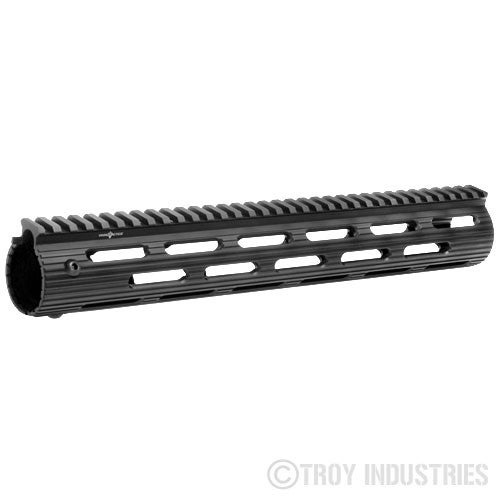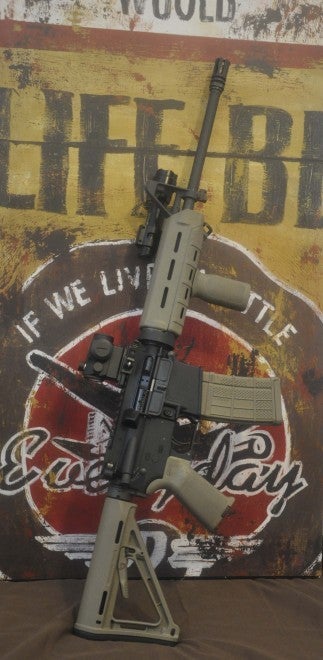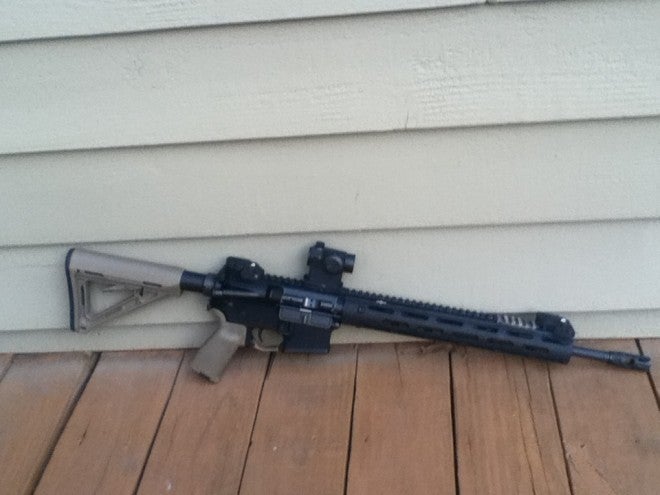Recently, I decided that my AR needed an upgrade to its forend. My Magpul MOE handguards had served valiantly for a year or two, but I wanted more. Changes in my shooting technique left me wanting a longer, lighter handguard. Because my rifle had carbine-length gas, and an A2 front sight block, my options were somewhat limited. I chose to chop the A2 block into a low profile block. This let me choose rails without cutouts for the block and let me extend the sight radius as well. Lacking the tools to remove and reinstall the barrel, I chose to stick with a rail that attaches directly to the standard barrel nut. With those choices made, I completed the installation with the tools I had on hand: a dremel, a crescent wrench, some punches, and a claw hammer.
Because of my restrictions on tools, I purchased a Troy VTAC 13” Alpha BattleRail.The VTAC Alpha is a tube-style forend, with a single 12-’o-clock rail running the length of the forend. It is available in a standard black anodized finish, as well as flat dark earth (tactical tan). Additional rail segments are included, and can be attached to any of the slots running down the tube. The 13” length provides a grip surface about an inch longer than rifle-length handguards, and with folding irons, a sight radius about an inch shorter than a rifle-length gun. On a 16” barreled gun, about 2.5” of barrel protrude from the handguard before the muzzle device.
Installing the tube was a breeze. To do this, you slide the rail over the barrel and gas block, and onto the bare barrel nut. The cuts on the inside of the rail line up with the ridges and valleys of the nut. The rail slides over the nut at a slight left-leaning angle, and when the rail bottoms out on the receiver, it can be rotated into place, in line with the receiver rail. A small tab of metal on the back end of the rail prevents the rail from rotating too far to the right. At this point all that is left is to tighten down the 3 allen screws with the included wrench. This closes the clamps that secure the rail tightly in place.
Like any product, this product has advantages and disadvantages, and of course, I’ve got opinions. The fit and finish of this tube is just superb. It is anodized aluminium, just like the receivers of an AR. It locks up tight on the barrel nut, and simply feels well-made. The rail is very lightweight, weighing in only slightly heftier than the plastic MOE carbine handguards I replaced, while being nearly twice as long, and having a full length top rail.
As I stated above, the rail is incredibly simple to install, once certain parts are out of the way. If I were to install again, I would purchase a low-profile gas block instead of cutting down an A2 FSB, simply because I’m a lazy SOB and a commercial low-pro looks nicer.
Another key feature I like is the modularity. I’m not a huge fan of quad-rails simply because all the extra unused rail estate is simply dead weight, adds girth to the forend, and snags on things constantly without rail covers, which add even more weight and bulk. I can add side and bottom rails as I need them, and I can also add them at 45 degree angles instead of just the common 90 degree placements. Right now I don’t use any of the additional provided rails on my rifle, opting for a clean forend, with just a folding front sight and a small patch of rail cover as an index for my grip.
Finally, in addition to all the above, it’s also a free-floating handguard, which lets the shooter put a great deal of weight on the forend without changing the rifle’s point of impact, putting the force on the upper instead of directly on the barrel.
Of course, this product has some drawbacks too. Primarily, like most Troy products, you pay for the quality you receive, in this case, $199 MSRP. For the two benjamins though, I received a lighter rifle with a longer sight radius, and much nicer handling. I’d say it was plenty worth it.
Lastly, the plain black model has some heat issues. If you leave it sitting in open sunlight on a hot day, or rip off some longer rapid-fire strings, the rail can get rather painful to hold, especially near the gas block. Some shooters wear a glove when shooting, or take and wrap paracord around the rail where they place their hands. Others have purchased heavy nylon wraps to attach to the rail to protect themselves from the heat. I have heard reports that the FDE model doesn’t suffer these issues, and that a simple application of a lighter colored spray paint acts as a heat reflector, and mitigates this problem.
Bottom line, I feel that this was one of the best purchases I made to improve my AR, and don’t hesitate to recommend this product to others looking to upgrade an existing rifle, or to complete a new build.
 Your Privacy Choices
Your Privacy Choices


